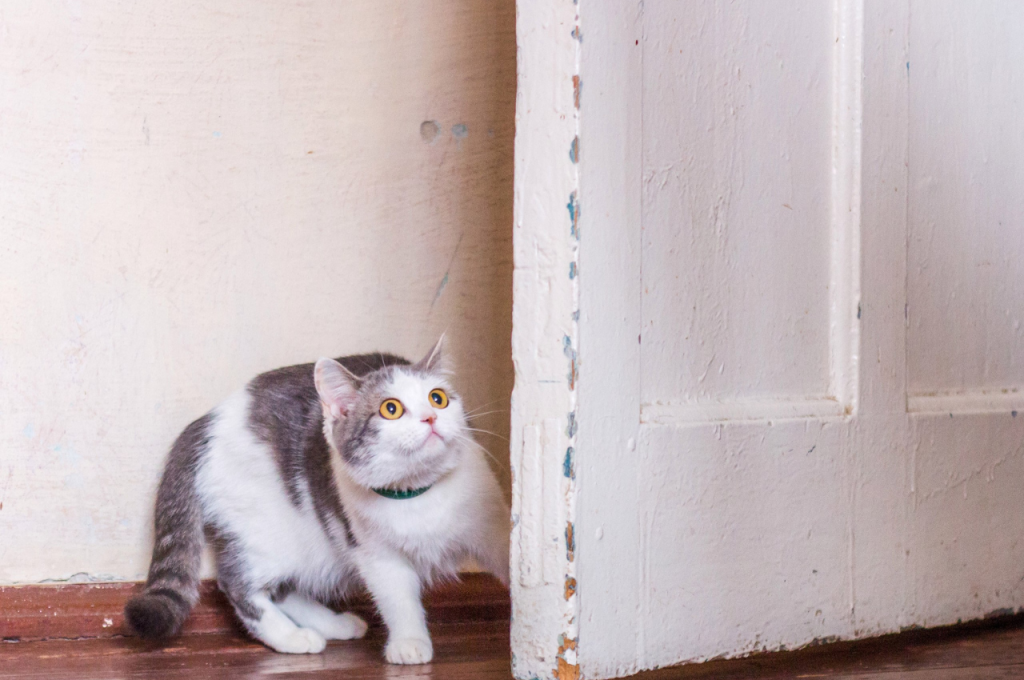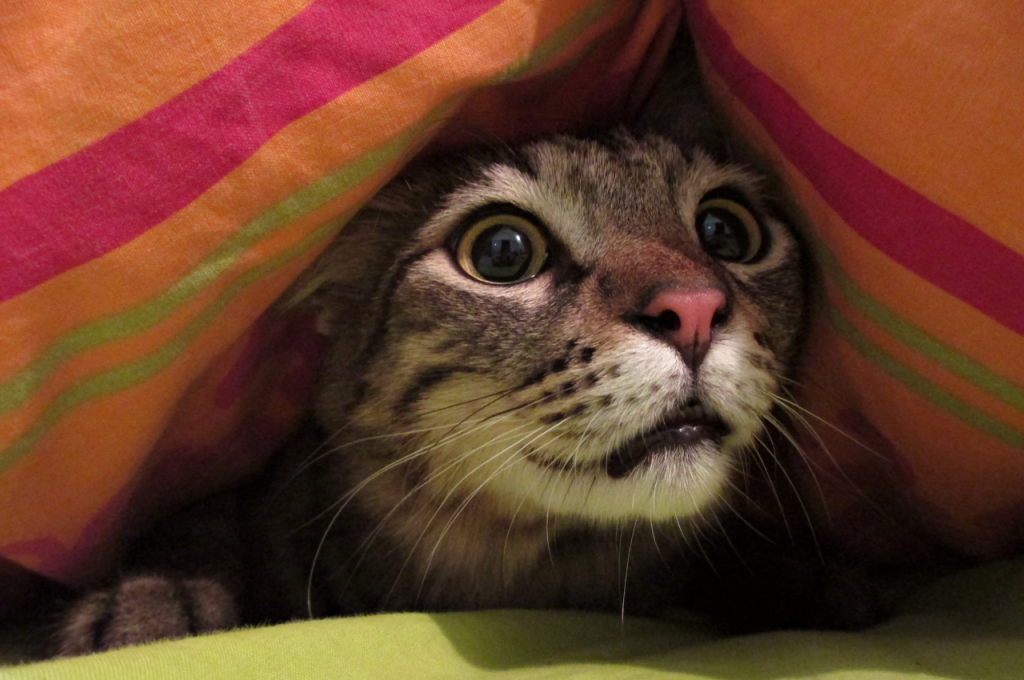To comfort a scared cat, create a calm and safe environment for them, and offer gentle reassurance and affection. Allow the cat to hide in a quiet, secure space where they feel protected.
Speak softly and avoid sudden movements that could startle them further. Offering treats or a favorite toy can help build trust and provide a distraction from their fear. Gradually approach the cat at their own pace, letting them come to you when they feel ready. You can also use calming sprays or diffusers, such as those with pheromones, to reduce anxiety. Patience is key to respecting your cat’s boundaries while providing consistent comfort and security.
Recognizing Fear in Cats
Recognizing fear in cats is crucial for ensuring their well-being and comfort. Common signs of a fearful cat include flattened ears, dilated pupils, and a low body posture. A scared cat may hide or seek refuge in enclosed spaces, avoiding interaction or eye contact. You might also observe defensive behaviors like hissing, growling, or swatting if they feel threatened.

Additionally, a cat may exhibit excessive grooming or sudden changes in appetite as coping mechanisms for stress. It’s essential to pay attention to these signals and create a safe environment where your cat feels secure. Understanding these fear indicators allows you to address their needs and help them feel more comfortable in their surroundings.
Physical Signs of Distress
Cats may display physical signs of distress when they are fearful. These can include dilated pupils, flattened ears, trembling, hiding, panting, or excessive grooming. It’s important to pay attention to these cues to understand when your cat is feeling scared.
Behavioral Indicators of Anxiety
Behavioral indicators of anxiety in cats can include hiding, aggression, excessive vocalization, urinating or defecating outside the litter box, and excessive grooming. If you notice any of these behaviors, it’s essential to address your cat’s anxiety and provide comfort.
Immediate Comfort Measures
To comfort a scared cat, immediate measures can significantly reduce their anxiety and help them feel secure. Start by providing a quiet, safe space where your cat can retreat, away from loud noises or commotion. Use soft bedding or a familiar blanket to create a cozy spot. Speaking softly and reassuringly can help ease their fear; gentle petting may also be comforting if your cat is receptive to it. Offering treats or their favorite toys can help distract them and encourage them to engage in calming activities.
Additionally, consider using pheromone diffusers or sprays, as they can promote a sense of safety and relaxation. Monitoring your cat’s body language and respecting their boundaries is crucial for providing comfort effectively.
Safe Space Creation
Create a quiet, safe space for the cat to retreat to. Use a cozy bed or a favorite blanket to provide comfort. Place the space in a secluded area away from noise and activity.
Gentle Approach Techniques
Approach the scared cat slowly and calmly. Avoid making sudden movements or loud noises. Speak in a soft, soothing tone to reassure the cat. Offer treats or toys to help the cat feel more at ease.
The Role of Environment
When it comes to comforting a scared cat, the environment plays a crucial role in helping them feel safe and secure. Creating a soothing and familiar space can minimize their anxiety and encourage them to relax. Let’s explore some key aspects of the environment that can help comfort a scared cat.
Minimizing Loud Noises
Loud noises can be extremely distressing for cats, especially when they are already feeling scared or anxious. Minimize loud noises by keeping the environment as quiet as possible. Close windows to reduce outside noise and avoid running noisy appliances or playing loud music. Providing a peaceful and tranquil environment can significantly calm a scared cat.
Familiar Scent Importance
The sense of smell is incredibly important to cats, and familiar scents can provide comfort and reassurance. Introduce familiar scents by placing their favorite blanket, bed, or toys in the area where they are seeking refuge. This can help create a sense of security and familiarity, easing their anxiety and helping them feel more at ease.
Calming Aids and Tools
Calm your scared cat with soothing aids and tools like cozy blankets, gentle petting, and soft music. Create a safe environment to provide comfort and reassurance during times of distress.
Cats can be easily frightened by various things like loud noises, unfamiliar surroundings, and sudden movements. It’s important to comfort them during such times and make them feel safe and secure. One way to do this is by using calming aids and tools specifically designed for cats. Here are some of the most effective calming aids and tools that you can use to comfort your scared cat.
Pheromone Diffusers and Sprays
Pheromones are natural chemicals that cats use to communicate with each other. They release these chemicals from their bodies to mark their territory and to signal safety and comfort. Pheromone diffusers and sprays mimic these natural chemicals and can help calm down a scared cat. They come in two forms: plug-in diffusers and sprays. Plug-in diffusers are devices that you plug into an electrical outlet and release pheromones into the air. Sprays, on the other hand, are directly applied to your cat’s bedding, carrier, or the room they are in.
Comforting Toys and Blankets
Comforting toys and blankets can be a great way to help your cat feel safe and secure. These toys and blankets are designed to mimic the warmth and comfort of their mother’s embrace. They can help reduce anxiety and stress in your cat. You can choose from a variety of toys and blankets specifically designed for cats, including cuddle toys, plush blankets, and heated beds

Using calming aids and tools can help your scared cat feel more comfortable and relaxed. Pheromone diffusers and sprays, comforting toys, and blankets can all help reduce anxiety and stress in your cat. However, it’s important to note that these tools are not a substitute for proper medical care. If your cat’s anxiety persists or worsens, it’s important to consult with your veterinarian to ensure they receive the proper care and treatment.
Interactive Techniques
One effective interactive technique to comfort a scared cat is to speak to them softly and offer gentle petting. Use a reassuring tone of voice and avoid sudden movements to help them feel secure. Additionally, providing a cozy hiding spot or a familiar blanket can also help ease their anxiety.
Soothing Voice Usage
Speak gently to your cat to provide reassurance.
Petting and Massage Strategies
Use slow, gentle strokes to calm your scared cat. Incorporate soft words and slow movements to comfort your feline.
Comforting Environment Setup
Create a safe space with cozy blankets and toys. Establish a routine to build trust and security for your cat.
Play Therapy and Distraction
Engage in interactive play sessions to divert attention. Use toys and treats as positive reinforcements for encouraging relaxation.
Professional Help Consideration
Consult a veterinarian or animal behaviorist for expert advice. Seek guidance for long-term strategies to address anxiety in your cat.
Long-term Solutions
To comfort a scared cat for the long term, create a safe and secure environment with hiding spots, cozy bedding, and soothing music. Gradually expose the cat to the source of fear through positive reinforcement and gentle encouragement, ensuring a calm and patient approach to build trust over time.
Cats are known for their cautious and fearful nature, which can sometimes lead to anxiety and stress. As a responsible cat owner, it’s your job to provide your feline friends with a safe and comforting environment that will help them overcome their fears and anxiety. In this blog post, we will discuss some long-term solutions to help comfort your scared cat.
Routine Establishment
Establishing a routine is one of the most important things you can do to help your scared cat feel more secure. Cats thrive on routine, and having a predictable schedule can help reduce their anxiety. Make sure your cat has a consistent feeding schedule, and stick to a regular playtime routine. This will help your cat feel more comfortable and secure in their environment.
Behavioral Training
Behavioral training is another effective long-term solution for comforting a scared cat. Through positive reinforcement training, you can help your cat learn to associate certain behaviors with rewards. For example, if your cat is scared of being picked up, you can train them to associate being picked up with a treat or praise. This will help your cat feel more comfortable and less fearful in the long run. By establishing a routine and implementing behavioral training, you can help your scared cat feel more comfortable and secure in their environment. It’s important to remember that every cat is different, and what works for one cat may not work for another. Be patient and consistent, and with time, your scared cat will learn to trust and feel safe in their home.
Diet and Nutrition
To comfort a scared cat, it’s important to create a safe and quiet space for them to retreat to. Offering gentle petting and soothing words can help reassure your feline friend. Additionally, providing familiar scents and comforting treats can also aid in easing their anxiety.
Anxiety-reducing Foods
Certain foods can help reduce anxiety in scared cats.
- Foods rich in omega-3 fatty acids can calm nerves
- Lean proteins like chicken and turkey aid in relaxation
- Pumpkin and oatmeal can soothe an anxious stomach
Supplements for Nervous Cats
Supplements can aid in calming scared cats:
- L-Theanine promotes relaxation
- Chamomile is a natural sedative
- CBD oil has calming effects on anxious cats
Preventive Strategies
Helping a scared cat requires gentle and patient techniques. Start by creating a calm environment with soft lighting and soothing music. Use pheromone diffusers to reduce anxiety and provide hiding spots for comfort. Speak softly and move slowly to gradually build trust and alleviate fear.

Cats can be easily scared by a number of things such as loud noises, unfamiliar surroundings, and strangers. While it is natural for them to feel scared, it is important to make them feel safe and secure in their environment. One of the best ways to comfort a scared cat is to take preventive measures to avoid stressful situations. In this section, we will discuss some preventive strategies that can help keep your cat calm and relaxed.
Stress Triggers to Avoid
There are several things that can trigger stress in cats, and it’s important to identify them to prevent your cat from feeling scared. Some common stress triggers to avoid include:
- Loud noises like thunderstorms, fireworks, and construction work
- Other pets or animals in the house or outside
- Changes in routine or environment
- Visitors or strangers in the house
- Physical punishment or yelling
By avoiding these stress triggers, you can help your cat feel safe and secure in their environment.
Creating a Cat-friendly Home
Another important preventive strategy is to create a cat-friendly home. This means providing a safe, comfortable, and stress-free environment for your cat. Here are some tips to create a cat-friendly home:
| Tips for a Cat-Friendly Home |
| Provide a cozy and comfortable bed |
| Offer plenty of hiding spots like cat trees and tunnels |
| Keep litter boxes in quiet and private areas |
| Provide plenty of fresh water and food bowls |
| Offer toys and scratching posts to keep your cat occupied |
| Keep the environment clean and free of clutter |
| Use pheromone sprays or diffusers to create a calming environment |
By creating a cat-friendly home, you can help your cat feel safe and secure in their environment, reducing their chances of feeling scared or stressed. In conclusion, preventive strategies are crucial for comforting a scared cat. By avoiding stress triggers and creating a cat-friendly home, you can help your cat feel safe and secure in their environment. Remember to always be patient and gentle with your cat, and seek professional advice if your cat continues to feel scared or stressed.
Conclusion
In times of fear, cats need reassurance and patience. By creating a safe space and using calming techniques, you can comfort your scared cat effectively. Remember, understanding their behavior is key to helping them feel secure and loved. With a gentle approach, you can build trust and alleviate their anxiety.
